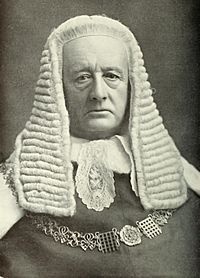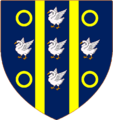Richard Webster, 1st Viscount Alverstone facts for kids
Quick facts for kids
The Viscount Alverstone
|
|
|---|---|
 |
|
| Lord Chief Justice of England | |
| In office 24 October 1900 – 21 October 1913 |
|
| Monarch | Queen Victoria Edward VII George V |
| Preceded by | The Lord Russell of Killowen |
| Succeeded by | The Earl of Reading |
| Master of the Rolls | |
| In office 9 May 1900 – 24 October 1900 |
|
| Monarch | Queen Victoria |
| Prime Minister | The Marquess of Salisbury |
| Preceded by | Sir Nathaniel Lindley |
| Succeeded by | Sir Archibald Levin Smith |
| Attorney General for England | |
| In office 27 June 1885 – 28 January 1886 |
|
| Monarch | Queen Victoria |
| Prime Minister | The Marquess of Salisbury |
| Preceded by | Sir Henry James |
| Succeeded by | Sir Charles Russell |
| In office 5 August 1886 – 11 August 1892 |
|
| Monarch | Queen Victoria |
| Prime Minister | The Marquess of Salisbury |
| Preceded by | Sir Charles Russell |
| Succeeded by | Sir Charles Russell |
| In office 8 July 1895 – 7 May 1900 |
|
| Monarch | Queen Victoria |
| Prime Minister | The Marquess of Salisbury |
| Preceded by | Sir Robert Reid |
| Succeeded by | Sir Robert Finlay |
| Personal details | |
| Born |
Richard Everard Webster
22 December 1842 Holborn, London United Kingdom |
| Died | 15 December 1915 (aged 72) Cranleigh, Surrey United Kingdom |
| Resting place | West Norwood Cemetery Lambeth, London United Kingdom |
| Political party | Conservative |
| Alma mater | Trinity College, Cambridge |
| Occupation | Barrister, judge |
Richard Everard Webster, 1st Viscount Alverstone (1842–1915) was an important British lawyer, politician, and judge. He held many high-ranking positions in the government and legal system.
Contents
Early Life and Education
Richard Webster was born on December 22, 1842, in Holborn, London. His father, Thomas Webster, was also a well-known lawyer. Richard went to King's College School and Charterhouse School. Later, he studied at Trinity College, Cambridge.
A Talented Athlete
In his younger years, Richard was a very good athlete. He represented his university in the first-ever inter-university steeplechase race. He was also a strong runner. Because of his athletic achievements, the Cambridge University Alverstone Club is named after him. This club still makes a special trip to Alverstone on the Isle of Wight every four years.
Richard kept his love for sports throughout his life. He was interested in cricket and foot-racing. He even helped set the rules for sports like long jump and shot put. He was the President of the Surrey County Cricket Club from 1895 until he died. He also led the Marylebone Cricket Club in 1903.
Legal and Political Career
Richard Webster became a lawyer in 1868. Just ten years later, he became a Queen's Counsel (QC). This meant he was a very senior and respected lawyer. He mostly worked on cases involving business, railways, and inventions.
Becoming Attorney-General
In 1885, Richard was chosen to be the Attorney-General. This is the main legal advisor to the government. It was unusual because he had not been a Solicitor-General first, and he wasn't even a Member of Parliament at the time! He soon won a seat in Parliament, first for Launceston and then for the Isle of Wight. He served as Attorney-General for many years, from 1885 to 1900, except for a few short breaks.
Important Legal Cases
Richard Webster handled several major legal cases during his career.
- In 1890, he was the main lawyer for The Times newspaper in the Parnell inquiry.
- In 1893, he represented Great Britain in a dispute over the Bering Sea.
- In 1898, he did the same for a border dispute between British Guiana and Venezuela.
Rise to Judge
In 1885, he was made a Knight Bachelor, which meant he could be called "Sir Richard Webster." In 1893, he received another important honor, becoming a Knight Grand Cross of the Order of St Michael and St George.
In 1900, he was given the title of Baron Alverstone. This meant he became a member of the House of Lords. Soon after, he became the Master of the Rolls, a senior judge. Later that same year, he reached the highest judicial position: Lord Chief Justice. He led some famous trials, including that of Hawley Harvey Crippen.
Later Career and Retirement
In 1902, he received an honorary law degree from the University of Edinburgh. He also became a Fellow of the Royal Society. Later that year, he went to South Africa to look into how martial law was used during the Second Boer War.
In 1903, he was part of a commission that decided the border during the Alaska boundary dispute. His vote helped settle the matter, but it made him very unpopular in Canada.
Richard Webster retired in 1913. When he retired, he was given an even higher title: Viscount Alverstone. In 1914, he wrote a book about his life called Recollections of Bar and Bench.
Personal Life
In 1872, Richard Webster married Louisa Mary Calthrop. Sadly, she passed away in 1877. They had one son and one daughter. Their son, Arthur Harold Webster, died young in 1902 at age 28. To honor his son, Lord Alverstone built the Arthur Webster Hospital in Shanklin, Isle of Wight, which opened in 1905. The building is still used as a clinic today.
In 1886, he had a large house called Winterfold House built near Cranleigh in Surrey. He also designed the beautiful gardens around it.
Lord Alverstone passed away on December 15, 1915, at his home in Cranleigh, Surrey. He was 72 years old. He was buried at West Norwood Cemetery. Since he had no living children to inherit his titles, his peerages ended when he died.
Images for kids




